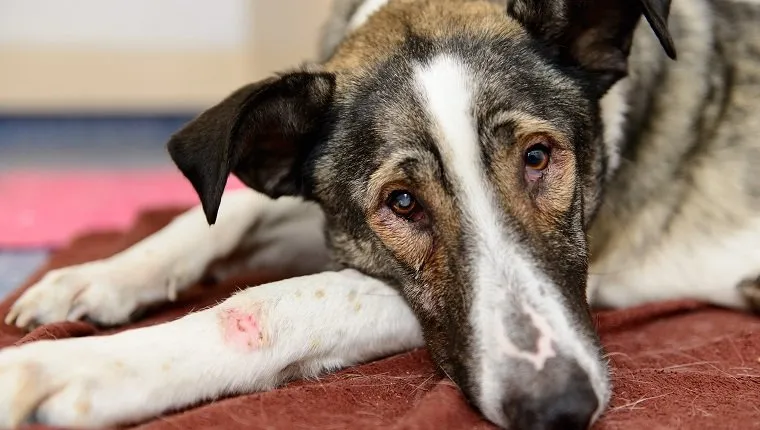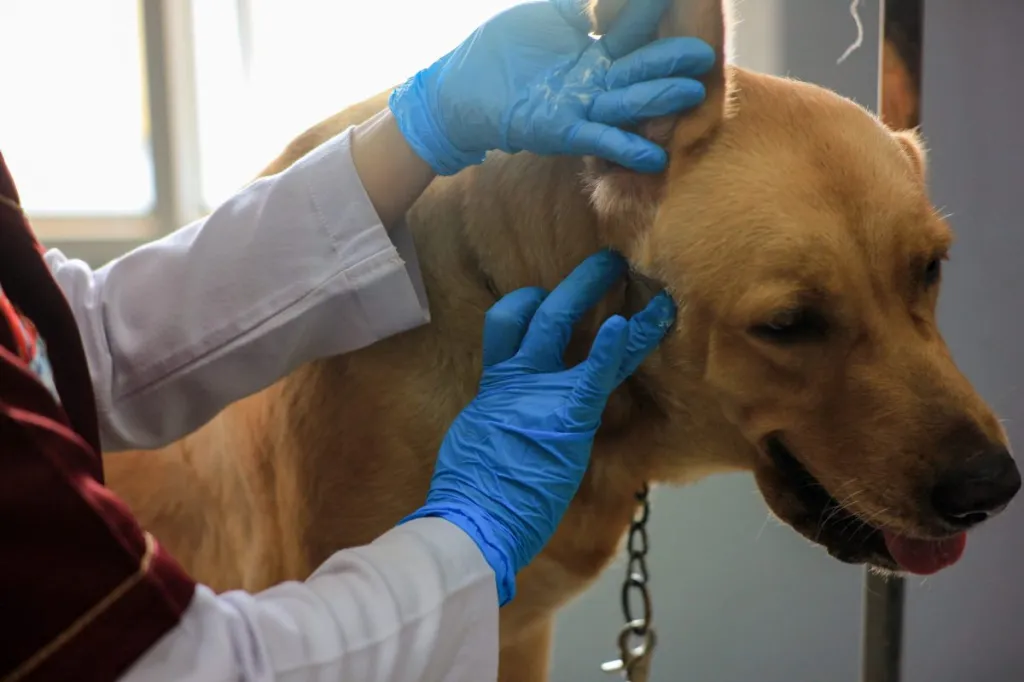Abscesses in dogs are localized pockets of pus that form in response to infections. They occur when the body’s immune system works to contain bacteria or other harmful pathogens that enter through a wound or infected area. While abscesses can develop anywhere on a dog’s body, they are most commonly found in regions more prone to injury, such as the head, neck, limbs, and base of the tail. Essentially, an abscess is the body’s way of isolating an infection to prevent it from spreading to other areas.
Here’s what you should know about the symptoms, causes, and treatments of abscesses in dogs.
Symptoms of abscesses in dogs

An abscess can manifest through various symptoms — which might be subtle or quite pronounced — depending on the severity and location of the infection. Here are some common signs to look out for:
- Visible swelling and redness
- Pain and sensitivity
- Heat in the affected area
- Pus or fluid discharge
- Lethargy
- Loss of appetite
- Fever
- Excessive licking or chewing at the site
- Foul odor
- Changes in behavior
- Swollen lymph nodes
It is important to note that an abscess may sometimes be mistaken for a cyst due to their similar appearance. However, they have different underlying causes and characteristics. Cysts are usually non-infectious and filled with fluid or other material. They develop gradually and are generally painless unless they grow large or rupture. Cysts can form due to blocked hair follicles, oil glands, or other benign conditions. In contrast, abscesses are caused by infections. They are typically painful, swollen, and may cause systemic symptoms such as fever and lethargy. An abscess often requires medical treatment to drain the pus and address the underlying infection.
Causes of abscesses in dogs

There are many types of abscesses in dogs, and they can range from small and superficial to large and dangerous. Abscesses have many potential causes but typically form when a wound becomes infected with bacteria. Abscesses form in response to these bacteria when a wound goes untreated.
Pasteurella multocida is the bacteria that most commonly causes skin infections in dogs. Staphylococcus intermedius is another bacteria that causes abscesses, and it can usually be treated with ointments.
Injuries that commonly get infected with bacteria resulting in abscesses include wounds in the mouth from sharp objects, bite wounds from other animals, and ingrown hairs.
Certain breeds have a predisposition to developing abscesses. These include the Chinese Shar-Pei, English Bulldog, and Labrador Retriever, all of which have short, stiff hairs that can get pushed back into the hair follicles and become infected, resulting in abscesses between the toes.
Outdoor dogs are also more susceptible to abscesses.
Skin, mouth, and lung injuries are more common in competitive or outdoor dogs because they have more opportunities to come into contact with sharp, dirty objects or to swallow or inhale grass awns, which are sharp seeds that can dig into tissue.
Dogs who have not been neutered or spayed also tend to develop abscesses because they are more likely to fight with other animals and get bite wounds. Furthermore, older male dogs who haven’t been neutered are at higher risk of prostate disease, which can result in prostate abscesses, and un-spayed older females are at higher risk of mammary gland infections that can result in abscesses.
Other causes include impacted anal sacs, blood infections that result in liver abscesses, tooth damage that can cause root abscesses, and ear, sinus, or mouth infections that can cause brain abscesses.
Almost any wound, even a small one, can become infected and cause an abscess in the body.
Treatments for abscesses in dogs

Most external abscesses can be treated by a veterinarian as an easy, out-patient procedure. This treatment usually includes lancing the abscess for proper drainage or surgically removing it.
Occasionally anesthesia will be necessary. Antibiotics are a must to help fight off and prevent further infection.
Anti-inflammatory drugs may also be prescribed to reduce swelling. The site of the abscess should be monitored to ensure proper healing, and a follow-up veterinary exam will likely be required later.
A vet may recommend an Elizabethan collar or bandages to prevent licking an chewing. You may also wish to use topical ointments or solutions for future skin issues to prevent infection.
For some abscesses, your veterinarian may use more specific treatment.
Tooth root abscesses, for instance, can be treated by pulling the affected tooth or performing a root canal. Lung, liver, and pancreatic abscesses may require surgery. Infected anal sacs may also be surgically removed.
Vets can remove most abscesses without further complications, though internal abscesses that rupture can spread bacteria to other organs and parts of the body. This is why it is important to treat abscesses quickly and thoroughly.









